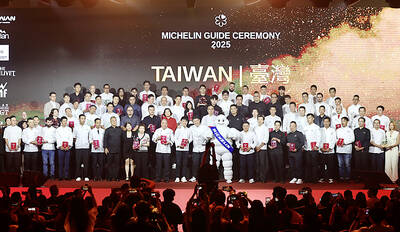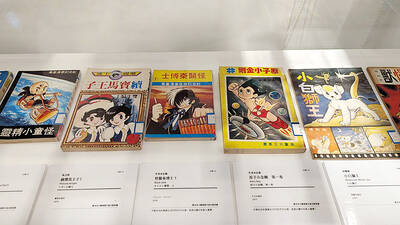Democratic Progressive Party Legislator Hsu Chih-chieh (許智傑) yesterday questioned the use of the “begonia” map in the armband insignia of some branches of the military.
The “begonia” map, so named because it resembles a begonia leaf, depicts an extended swath of pre-1949 Republic of China (ROC) territory, which notably includes Outer Mongolia.
Hsu said the use of the “begonia” map in the insignia symbolizes a “greater China mindset,” and urged the military to change it.

Graphic courtesy of the office of Democratic Progressive Party Legislator Hsu Chih-chieh
New insignia could use images symbolic of Taiwan, such as the Formosan black bear or the Taiwan blue magpie, Hsu said.
Hsu was speaking at a meeting of the legislature’s Foreign Affairs and National Defense Committee, suggesting a review of the stipulations in the Armed Forces Uniform Act (陸海空軍服制條例) and other relevant laws.
Hsu compared the issue to past discussions about the Chinese Nationalist Party’s (KMT) emblem, which has been said to closely resemble the national emblem, and is therefore no longer appropriate as Taiwan is no longer a one-party state.
Similarly, the military armband insignias do not reflect the current situation in Taiwan, he said.
Military insignias also do not need to incorporate the national emblem, he said, citing US military insignia, some of which do not use the bald eagle.
Army Lieutenant General Fang Mao-hung (房茂宏) said the use of the map in the insignia was in accordance with the national territory described in the ROC Constitution.
The map includes territory effectively under the government’s administration, as well as that constitutionally recognized, but not under the government’s administrative control, he said.
“The entire military is loyal to the nation, loyal to the Constitution and executes orders in accordance with the law. This must not be questioned,” he said.
Hsu asked why the insignia used by the Republic of China Marine Corps still uses the “begonia” map, despite being redesigned in April 2019.
Military insignia should not be bound to tradition, which would cause divisiveness, Hsu said.
He also cautioned against the use of the national emblem on the hats of military personnel, saying its resemblance to the KMT emblem could cause confusion.
“There is no problem with the military being loyal to the Republic of China, Taiwan. However, it should consider more neutral designs for emblems to avoid ideological problems,” he said.

Eight restaurants in Taiwan yesterday secured a one-star rating from the Michelin Guide Taiwan for the first time, while three one-star restaurants from last year’s edition were promoted to two stars. Forty-three restaurants were awarded one star this year, including 34 in Taipei, five in Taichung and four in Kaohsiung. Hosu (好嶼), Chuan Ya (川雅), Sushi Kajin (鮨嘉仁), aMaze (心宴), La Vie by Thomas Buhner, Yuan Yi (元一) and Frassi in Taipei and Front House (方蒔) in Kaohsiung received a one-star rating for the first time. Hosu is known for innovative Taiwanese dishes, while Chuan Ya serves Sichuan cuisine and aMaze specializes

Taitung County is to launch charter flights to Malaysia at the end of this year, after setting up flights to Vietnam and Thailand, the Taitung County Government said yesterday. The new charter flight services, provided by low-cost carrier Batik Air Malaysia, would be part of five-day tour packages for visits to Taitung County or Malaysia. The Batik Air charter flight, with about 200 seats, would take Malaysian tourists to Taitung on Dec. 30 and then at 12:35pm return to Kuala Lumpur with Taiwanese tourists. Another charter flight would bring the Taiwanese home on Jan. 3 next year, arriving at 5:30pm, before taking the

Taiwan High Speed Rail Corp. (THSRC) plans to ease strained capacity during peak hours by introducing new fare rules restricting passengers traveling without reserved seats in 2026, company Chairman Shih Che (史哲) said Wednesday. THSRC needs to tackle its capacity issue because there have been several occasions where passengers holding tickets with reserved seats did not make it onto their train in stations packed with individuals traveling without a reserved seat, Shih told reporters in a joint interview in Taipei. Non-reserved seats allow travelers maximum flexibility, but it has led to issues relating to quality of service and safety concerns, especially during

An exhibition celebrating Taiwan and Japan’s comic culture opened on Saturday in Taichung, featuring a section that explores Taiwanese reproductions of Japanese comics from when martial law limited Japanese representation. “A Century of Manga Culture: An Encounter of Taiwan and Japan’s Youth” held its Taiwan opening ceremony at Taichung’s National Taiwan Museum of Comics after an initial one-month run in Japan’s Kyoto International Manga Museum between May 24 and June 24. Much like the Kyoto exhibition, the show mainly celebrates the comic connection between Taiwan and Japan through late Taiwanese comic book